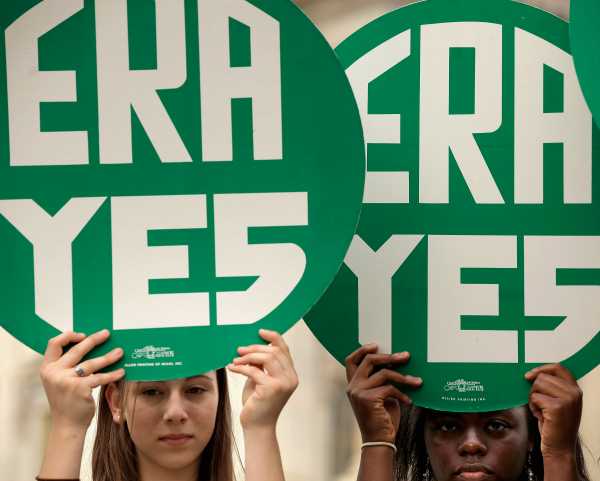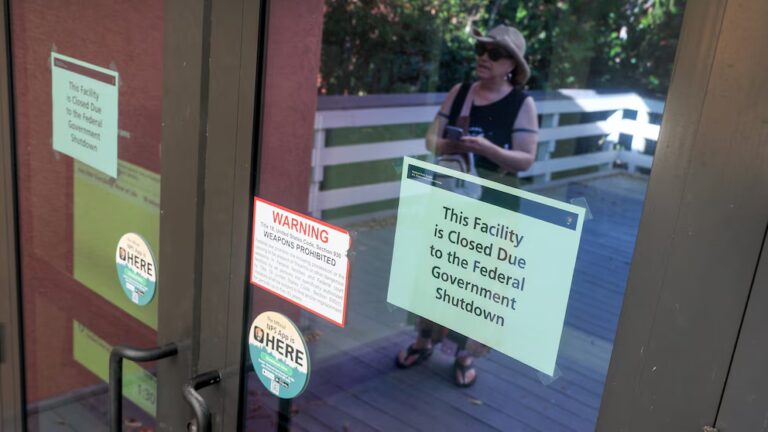
The Equal Rights Amendment is closer than it’s ever been to becoming a reality after Democrats took control of both the House and Senate in Virginia on Tuesday. But even if the state ratifies the ERA, there’s still a looming legal debate over whether it can actually be enshrined in the United States Constitution.
The ERA, an amendment that guarantees equal rights regardless of sex, passed Congress on a bipartisan basis in 1972 and requires 38 states to ratify it in order to become part of the Constitution. Thirty-five states rapidly did, the last being Indiana in 1977, but then its momentum was halted when it became a culture war battleground.
It took 40 years for a 36th state — Nevada — to ratify the ERA in 2017, and then Illinois became the 37th state in 2018.
That brings the country within one state of meeting the bar. And Democrats in Virginia, who took control of both state’s legislative bodies on Tuesday, have said they plan to ratify the ERA, which would make Virginia the 38th and final state. “One thing we are going to need to do right away is pass the Equal Rights Amendment in Virginia,” state Senate Democratic leader Dick Saslaw told supporters on Tuesday, according to CNN. “It’s high time we include the women of this country in the Constitution of the United States.”
Virginia’s ratification doesn’t directly translate to the ERA finally making it into the Constitution — it’s decades past the deadline Congress set for that to happen. The ERA’s supporters say there’s a legal workaround, so we may soon find out whether it will work.
The Equal Rights Amendment had a lot of momentum behind it in the 1970s, and then it just sort of petered out
The Equal Rights Amendment dates back to the 1920s and came about after the 19th Amendment, which gave women the right to vote. It was first introduced by suffragist leader Alice Paul in 1923, and has three simple parts:
The amendment gained momentum in the 1960s and ’70s, culminating with passage in the US Senate and the House of Representatives in 1972, which put it on track to become what would have been the 27th Amendment in the Constitution. It was sent to the states for ratification and put on a seven-year deadline.
Support was, initially, bipartisan and broad. In the first year after the amendment was passed, 22 states ratified it.
But opposition began to emerge, led by anti-feminist conservative leader Phyllis Schlafly, who argued the ERA would erase legal differences between men and women and would lead to an America where men wouldn’t be required to support their wives, anyone could walk into any bathroom, women could be drafted, and same-sex marriage would be legalized. Schlafly died in 2016 at the age of 92.
“Since the women are the ones who bear the babies, and there’s nothing we can do about that, our laws and customs then make it the financial obligation of the husband to provide the support,” Schlafly said in 1973. “It is his obligation and his sole obligation. And this is exactly and precisely what we will lose if the Equal Rights Amendment is passed.”
Schlafly’s line of attack caught on, as did others — that the ERA’s passage would expand abortion rights, that it would infringe on states’ rights, that it would be costly to businesses. Indiana became the 35th state to ratify the ERA in 1977. Then its momentum stalled.
The ERA has gotten new life in recent years
After lying dormant for decades, the ERA has begun to gain momentum in recent years. Nevada ratified it in 2017, Illinois in 2018, and now Virginia appears to be on the cusp of doing so.
Activists point to a number of factors contributing to the amendment’s revival, including the #MeToo movement, the backlash to Donald Trump’s presidency and Hillary Clinton’s 2016 loss, and the number of women who have entered into the political arena as of late. During the 2019 State of the Union address, many Democratic women in Congress wore pins that read “ERA Yes.”
“There’s been a lot more interest and a lot more attention in the news media about some of the wrongs against women and the inequalities that we face,” Roberta Madden, the co-president of the ERA-NC Alliance in North Carolina, told me last year. “That’s focused the attention in a way that it hasn’t before.”
The 2016 documentary Equal Means Equal renewed attention on the issue as well.
Virginia got close to ratifying the ERA last year, but the GOP-controlled legislature ultimately rejected it. A House committee refused to take it up, and a Senate panel defeated it 9 to 5. Men cast all of the “no” votes. With Democrats in control, hopes are high that next time around will be different.
The ERA missed its deadline. Supporters argue it could still get another chance.
A 38th state ratifying the ERA wouldn’t be the end of it. It’s 37 years past the deadline Congress set for it to become a constitutional amendment: Congress originally set a 1979 deadline, and when that date hit, the amendment only had 35 ratifications. Congress extended the deadline to 1982, but it missed that as well.
Still, there are some potential workarounds.
A 2013 report by the Congressional Research Service said Congress could just vote to change the previous deadline.
Rep. Jackie Speier (D-CA) and Sen. Ben Cardin (D-MD) introduced legislation in 2017 that would remove the ratification deadline for the ERA. “If Congress, by majority vote, said that the deadline was ’82, then Congress by majority vote could say that the deadline is many years from now,” Jane Mansbridge, a Harvard professor and the author of Why We Lost the ERA, said in a 2018 interview with the Harvard Kennedy School PolicyCast.
Supporters of the ERA also point to the “Madison Amendment.” In 1789, James Madison first proposed that Congress shouldn’t be allowed to give itself a raise — any pay increases wouldn’t take effect until the next congressional term began. Six states had ratified the amendment by 1792. Then the effort stalled for 190 years. In 1982, an undergraduate student, Gregory Watson, figured out that the amendment could still be ratified and started what would eventually become a successful grassroots campaign to ratify, in 1992, the 27th Amendment.
Some Republicans at the state level have supported the ERA, and its supporters hope that many of the myths and misconceptions about it have dissipated. It was, at least initially, a bipartisan issue in the 1970s, and it could be again.
In 2014, Supreme Court Justice Ruth Bader Ginsburg said at the National Press Club that if she could choose any amendment to add to the US Constitution, it would be the Equal Rights Amendment. “I think we have achieved that through legislation, but legislation can be repealed, it can be altered,” Ginsburg continued. “So I would like my granddaughters, when they pick up the Constitution, to see that notion — that women and men are persons of equal stature — I’d like them to see that is a basic principle of our society.”
Sourse: vox.com






